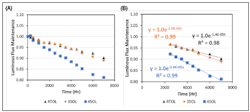DOE releases new report on OLED panel longevity and performance
The US Department of Energy published a “round 2” update of its research stress testing OLED panels, seeking to understand degradation pathways and the report details performance testing of a new OLEDWorks panel.
The US Department of Energy (DOE) has announced results of its ongoing research testing OLED solid-state lighting (SSL) technology with a focus on general illumination applications. In a new “round 2” report based on accelerated stress testing of OLED panels, the researchers found improvement in the latest products, yet longevity still trails LED significantly. The report also includes an analysis of the new OLEDWorks Brite 3 panel after 1500 hours of testing.
OLED remains a tantalizing technology for general lighting. The inherently diffuse panels are pleasing to most people. The thin panels offer product developers freedom of form. But manufacturing costs along with performance and reliability issues have limited OLED technology to niche uses in lighting. Meanwhile, planar edge-lit LED products are increasingly popular and able to offer some of the same benefits as OLED.
Still, the DOE has continued to support OLED research and fund projects that utilize the technology, believing that maturity would bring OLED nearer to LEDs in performance and reliability. The agency published a Gateway report of OLED office lighting back in 2017. And Caliper reports have detailed the photometric performance of commercial OLED products.
Currently, the DOE is struggling with funding with the Trump administration having less of a focus on energy efficiency. And we haven’t seen any Caliper or Gateway reports of late. But the agency still has continuing research, and OLED stress testing is one area where such work continues. The latest report seems to lie somewhere between a Gateway and a Caliper report with elements of each because some of the data presented is from field deployments like Gateway and other parts of the data are based on lab testing like Caliper.
Average luminous flux maintenance for OLEDWorks Brite 2 warm-white OLED panels (A) and exponential fits of the latter part of the data (B). (Image credit: US Department of Energy report.)
We will focus on the lab testing here. The researchers have been continuously operating populations of a number of panels from multiple manufacturers at slightly elevated ambient temperatures of 35°C or 45°C with test duration now up to 7000 hours. Moreover, the team has begun a more accelerated test of the relatively new Brite 3 panels from OLEDWorks, testing at 90°C and 90% humidity, and exposing the panels to power cycling. In each case, there is parallel operation of populations of the same products at normal conditions, with all of the Brite 3 tests lasting 1500 hours.
On the surface, the results look positive. Researchers have tested older OLEDWorks Brite 2 panels for 7000 hours in three stress protocols. Output flux maintenance remains above 85% in all cases. The researchers report the largest decline in output during the first 2000 hours, followed by a leveling off and then a predictable decline on a moderate scale. Moreover, chromaticity shift is much better in the more recent products that have been tested.
That said, the DOE pointed out that the performance after stress testing is poorer than some mid-power LEDs that were manufactured in 2011. And back in that timeframe, mid-power LEDs were not known for good performance over time or tough conditions as we documented.
As for the newest product tested, the Brite 3 panels achieved flux maintenance greater than 92% even with the exposure to a tougher operating environment. The researchers noted the escalated stress and the results indicate that OLEDWorks has improved its encapsulation technology. There was also very little chromaticity shift after 1500 hours.
The DOE is still a proponent of OLED technology serving as a complement to LED technology and suggests that the latest test results support that vision. Moreover, the researchers are now confident that the accelerated stress mechanisms are well understood and can be modeled using standard SSL industry methodologies such as a single-exponential decay function following an initial period of declining performance.
You can learn about the full details of the stress protocols and testing methodologies in the DOE report.

Maury Wright | Editor in Chief
Maury Wright is an electronics engineer turned technology journalist, who has focused specifically on the LED & Lighting industry for the past decade. Wright first wrote for LEDs Magazine as a contractor in 2010, and took over as Editor-in-Chief in 2012. He has broad experience in technology areas ranging from microprocessors to digital media to wireless networks that he gained over 30 years in the trade press. Wright has experience running global editorial operations, such as during his tenure as worldwide editorial director of EDN Magazine, and has been instrumental in launching publication websites going back to the earliest days of the Internet. Wright has won numerous industry awards, including multiple ASBPE national awards for B2B journalism excellence, and has received finalist recognition for LEDs Magazine in the FOLIO Eddie Awards. He received a BS in electrical engineering from Auburn University.





